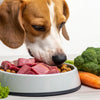How to Get a Dog to Eat Kibble: Tips and Tricks for Picky Eaters
- Houndsy
Table of Contents
- Introduction
- Understanding Your Dog’s Dietary Preferences
- Creative Solutions to Encourage Kibble Consumption
- The Role of the Houndsy Kibble Dispenser
- Conclusion
Introduction
Have you ever experienced the frustration of placing a bowl of kibble before your furry friend, only to watch them turn their nose up and walk away? You're not alone! It's a common scenario that many dog owners face. In fact, studies show that approximately 30% of dog owners report their pets as picky eaters at some point in their lives. This behavior can stem from various reasons, including health issues, boredom, or simply a desire for variety in their diet.
At Houndsy, we understand that feeding time is an essential aspect of pet care, and our mission is to enhance this daily ritual. In this blog post, we will explore effective strategies for encouraging your dog to eat kibble, while considering the potential reasons behind their pickiness. By the end, you’ll gain insights not only into how to get your dog to eat kibble but also how to make mealtime enjoyable and nutritious for your beloved companion.
We will cover:
- The importance of understanding your dog’s dietary preferences.
- Common reasons dogs may be reluctant to eat kibble.
- Creative solutions to entice your dog back to their food bowl.
- How the Houndsy Kibble Dispenser can simplify and elevate your dog feeding experience.
By addressing these areas, we aim to empower you with practical tools and knowledge to ensure your dog enjoys their meals while maintaining a healthy diet.
Understanding Your Dog’s Dietary Preferences
Recognizing Picky Eating
The first step in addressing your dog's refusal to eat kibble is to understand their behavior. Picky eating in dogs can manifest in different ways, such as refusing food altogether, eating only certain types of food, or showing reluctance to eat at specific times.
It's essential to differentiate between a genuine aversion to kibble and temporary issues like stress or minor health problems. Consider observing your dog's eating habits over a few days. Are they showing signs of discomfort while eating, such as pawing at their mouth or avoiding hard kibble? If so, it may be time to consult with your veterinarian to rule out underlying health issues.
Factors Influencing Your Dog’s Eating Habits
Several factors can influence a dog's willingness to eat kibble:
- Taste and Texture: Dogs, much like humans, have their preferences. Some may favor softer or moister food, while others enjoy crunchier textures. If your pup has been eating the same kibble for a long time, they may develop a condition known as "kibble fatigue."
- Health Issues: Conditions such as dental pain, gastrointestinal disorders, or nausea can significantly impact a dog’s appetite. If your dog has suddenly stopped eating kibble they once loved, a veterinary check-up is necessary.
- Stress and Environment: Changes in a dog's environment, such as moving to a new home or the arrival of a new pet, can lead to stress, which may affect their eating habits. Creating a safe, quiet feeding space can help alleviate these issues.
- Feeding Routine: Dogs thrive on routine. If their feeding schedule is inconsistent, it may lead to confusion and reluctance to eat. Maintaining a consistent feeding time can help your dog anticipate mealtime and feel more secure.
Understanding these factors is crucial in tailoring your approach to encourage your dog to eat their kibble.
Creative Solutions to Encourage Kibble Consumption
1. Enhance the Kibble's Flavor
Adding toppers to kibble can be an effective way to make it more appealing. Here are some healthy options:
- Bone Broth: This nutrient-rich liquid can give kibble a delightful flavor and aroma. Just ensure it’s low in sodium and free from onions or garlic.
- Pumpkin Puree: Unsweetened and canned pumpkin is not only tasty but also packed with fiber, which aids digestion.
- Cooked Eggs: Scramble or boil an egg for a protein boost. Many dogs find eggs irresistible, but always check for food sensitivities first.
2. Experiment with Food Temperature
Warming up kibble can enhance its smell, making it more enticing. A simple method is to add warm (not hot) water or broth to the kibble. This can stimulate your dog's appetite and make the meal feel more appealing.
3. Switch Up the Feeding Routine
If your dog seems bored with their current feeding routine, try changing the location where they eat or the time of day you feed them. A quiet, distraction-free area can help them focus on their meal. Additionally, consider using a puzzle feeder or slow feeder to turn mealtime into an engaging activity.
4. Gradually Transition to New Foods
If you think your dog might prefer another brand or type of food, introduce it gradually. Mixing a small amount of the new food with their current kibble over several days can help ease the transition and maintain their interest.
5. Limit Treats and Table Scraps
While it’s tempting to give your dog treats or table scraps, doing so can spoil their appetite for kibble. Establish a clear boundary around mealtime, and reserve treats for training or special occasions.
6. Monitor Portion Sizes
Sometimes, dogs refuse to eat because they are being overfed. Ensure you’re providing the appropriate portion size based on your dog’s weight and activity level. Consult your veterinarian for guidance on how much kibble your dog needs.
7. Use Positive Reinforcement
If your dog eats their kibble, shower them with praise and affection. This positive reinforcement can help them associate mealtime with good feelings, encouraging them to eat willingly in the future.
The Role of the Houndsy Kibble Dispenser
At Houndsy, we aim to simplify and elevate the dog feeding experience with our flagship product—the Houndsy Kibble Dispenser. This innovative dispenser not only provides perfect portion control but also enhances the aesthetic of your home with its mid-century modern design.
Key Features of the Houndsy Kibble Dispenser
- Convenient Crank Mechanism: Positioned at standing height, the crank allows you to dispense kibble without bending, making feeding time easier on your back.
- Large Storage Capacity: With a storage capacity of 25-30 lbs, you can keep a generous supply of kibble on hand without frequent refills.
- BPA-Free Liner: Our dispenser features a BPA-free liner to ensure kibble stays fresh and free from harmful chemicals.
- Auto-Locking Mechanism: This feature prevents accidental dispensing by curious pets or toddlers, making it a safe option for households with young children.
By utilizing the Houndsy Kibble Dispenser, you can turn the chore of feeding into a beautiful and functional experience that both you and your dog will enjoy. Explore our product page to learn more about how this innovative design can enhance your daily pet care routine. Order Now.
Conclusion
Getting your dog to eat kibble can be a challenging but manageable task. By understanding their dietary preferences and exploring creative solutions, you can encourage your furry friend to enjoy their meals once again. Remember, it's essential to be patient and attentive to their needs, and consult your veterinarian if you suspect any underlying health issues.
Our commitment at Houndsy is to improve the feeding experience for both pets and their owners. We believe that mealtime should be a joyful occasion, and with the right tools and knowledge, you can make it just that. Don’t forget to check out the Houndsy Kibble Dispenser to elevate your feeding routine!
FAQ
Why has my dog suddenly stopped eating kibble?
There can be various reasons for this behavior, including health issues, stress, boredom with their current food, or changes in their environment. Always consult your veterinarian to rule out any health concerns.
How can I tell if my dog is being picky or if there's a health issue?
Observe your dog's behavior closely. If they show signs of discomfort while eating, have changes in energy levels, or exhibit other unusual symptoms, a vet visit is warranted. If they simply refuse kibble without any other signs, they may just be picky.
What are some good toppers to add to kibble?
Healthy options include bone broth, pumpkin puree, cooked eggs, and plain yogurt. These can enhance the flavor and nutritional value of kibble.
Can I switch my dog’s food suddenly?
It's best to transition gradually to avoid digestive upset. Mix the new food with the old one over several days, slowly increasing the proportion of the new food.
How can I create a routine that encourages my dog to eat?
Establish a consistent feeding schedule, provide a quiet and safe feeding environment, and limit treats between meals to encourage your dog to eat at mealtime.












